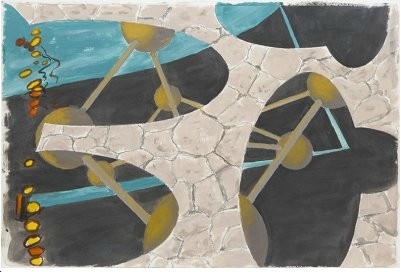William Leavitt
04 Apr - 04 May 2013
WILLIAM LEAVITT
Space Junk
4 April - 4 May 2013
Greene Naftali is pleased to announce Space Junk, an exhibition of new work by Los Angeles-based artist William Leavitt. This will be the artist’s first solo show in New York since 1981, and follows a major retrospective of Leavitt’s work at the Museum of Contemporary Art, Los Angeles, in 2011.
William Leavitt is among a generation of Los Angeles artists integral to the development of Conceptual art in the 1960s and early 70s. Drawing on the fictions and fantasies that power Los Angeles' chief industry as well as its singular architectural landscape, Leavitt’s distinctive body of work consists of distilled filmic moments that are familiar, yet estranged. In the artist’s mode of set-like installation, signifiers of the Southern California lifestyle float untethered to their original contexts, plucked from both the real built environment and its copy reproduced on studio sound stages.
Space Junk presents installations, paintings, and works on paper focused on this fractured, surreal perspective. Layering representations of the mechanical and electronic debris that populate the space around Earth with cultural relics from the modernist era of the last century, Leavitt examines the transmission of information and aspiration over time.
Warp Engines, an installation from 2009, is reminiscent of an aging modernist house, with a lamp left switched on indicating a recently departed resident. A hanging molecular model alternately resembles a classroom prop or a mid-century sculpture, while a soundtrack of electronic signals, trains whistles, and wafts of folk music suggests a garbled dispatch from abroad. Body Space, a new installation composed of a curved fiberglass wall, a rubber potted plant, and a swath of gravel, recalls a partition in a futurist office now long outdated. In a signature gesture Leavitt hangs a painting on the curved wall, proposing it as a prop in a narrative.
In the paintings and works on paper on view, geometric ellipses frame scenes of gardens, architectural elements, rock formations, and aerial views of Earth. Molecular structures are superimposed on several of the works, alternately alluding to retro home d袯r or a surrealist exercise in the micro and macroscopic. Motel Zion Earth, 2013, playfully depicts a view of Zion National Park layered with a floating, saucer-like soccer ball. Framed by the switchboard of an extraterrestrial object, and backed by a sparse piano soundtrack, the work speaks to a leisurely cinematic immersion—Earth's features, natural and manmade, from a distant IMAX theater.
Space Junk
4 April - 4 May 2013
Greene Naftali is pleased to announce Space Junk, an exhibition of new work by Los Angeles-based artist William Leavitt. This will be the artist’s first solo show in New York since 1981, and follows a major retrospective of Leavitt’s work at the Museum of Contemporary Art, Los Angeles, in 2011.
William Leavitt is among a generation of Los Angeles artists integral to the development of Conceptual art in the 1960s and early 70s. Drawing on the fictions and fantasies that power Los Angeles' chief industry as well as its singular architectural landscape, Leavitt’s distinctive body of work consists of distilled filmic moments that are familiar, yet estranged. In the artist’s mode of set-like installation, signifiers of the Southern California lifestyle float untethered to their original contexts, plucked from both the real built environment and its copy reproduced on studio sound stages.
Space Junk presents installations, paintings, and works on paper focused on this fractured, surreal perspective. Layering representations of the mechanical and electronic debris that populate the space around Earth with cultural relics from the modernist era of the last century, Leavitt examines the transmission of information and aspiration over time.
Warp Engines, an installation from 2009, is reminiscent of an aging modernist house, with a lamp left switched on indicating a recently departed resident. A hanging molecular model alternately resembles a classroom prop or a mid-century sculpture, while a soundtrack of electronic signals, trains whistles, and wafts of folk music suggests a garbled dispatch from abroad. Body Space, a new installation composed of a curved fiberglass wall, a rubber potted plant, and a swath of gravel, recalls a partition in a futurist office now long outdated. In a signature gesture Leavitt hangs a painting on the curved wall, proposing it as a prop in a narrative.
In the paintings and works on paper on view, geometric ellipses frame scenes of gardens, architectural elements, rock formations, and aerial views of Earth. Molecular structures are superimposed on several of the works, alternately alluding to retro home d袯r or a surrealist exercise in the micro and macroscopic. Motel Zion Earth, 2013, playfully depicts a view of Zion National Park layered with a floating, saucer-like soccer ball. Framed by the switchboard of an extraterrestrial object, and backed by a sparse piano soundtrack, the work speaks to a leisurely cinematic immersion—Earth's features, natural and manmade, from a distant IMAX theater.

